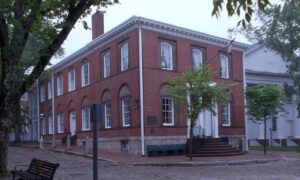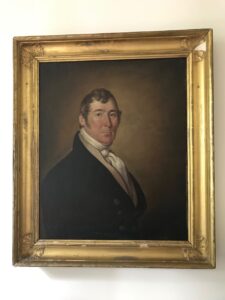 The Pacific Bank on Nantucket’s Main Street. The entrance to the cashier’s dwelling was accessed through the door with fan-light, at left, and the building as originally constructed ended at the downspout one window down from that door.
The Pacific Bank on Nantucket’s Main Street. The entrance to the cashier’s dwelling was accessed through the door with fan-light, at left, and the building as originally constructed ended at the downspout one window down from that door.
Two years ago, I described several gifts that Genealogy Santa had brought me for Christmas. In that post, I hinted at a forthcoming, very juicy story about a family member, but I have failed to follow through thus far. Then a few weeks ago, Jeff Record virtually threw down the gauntlet in search of family bank robbers … and tagged me in his post to boot! Challenge accepted.
First, a little backstory. My great-great-great-great-grandfather James Athearn was born in Providence, Rhode Island, and grew up in Boston and Martha’s Vineyard (his father’s birthplace). Very early in the nineteenth century—at about the time his father George went bankrupt in Boston—James moved to Nantucket, birthplace of his mother, Hephzibah/Hepsibah Hussey. I would not be surprised if he boarded with his mother’s sister, Lydia (Hussey) Cary, and her husband Edward. In any case, he married their daughter (and thus his first cousin) Lydia a year later!
In 1810, James was made cashier of the Pacific Bank, whose original location was on the site of the current St. Mary, Our Lady of the Isle Catholic Church. He served in this capacity for the next twenty-seven years … longer than anyone else who has held the position. Presumably he had a good head for figures, and so was made executor of his uncle/father-in-law’s estate when Edward Cary died in 1812.
Part of the new bank building’s design was the incorporation of on-site accommodations for the cashier and his family.
The Pacific Bank moved into a new building in 1818, at the intersection of Main and Centre Streets, where it still stands at the head of Main Street’s commercial district and provides a backdrop to the town’s Christmas tree every year.[1] Part of the new bank building’s design was the incorporation of on-site accommodations for the cashier and his family. At least in part, this was due to a very unfortunate incident in 1795 in which a newly-chartered bank on Nantucket was robbed of all its deposits two weeks after opening. Although there was plenty of evidence that it had been done by off-island robbers, many prominent residents of the island (including Walter Folger, Jr., later a Congressman from Massachusetts) spent years pointing fingers at neighbors as the likely culprits. This incident cast a pall over the Nantucket banking community for decades … though in truth there was not a bona fide bank robbery again until Memorial Day Weekend 2010!
That is not to say that banks on the island did not find themselves victims of crime; it just came through the hands of their employees. William Chadwick, cashier of the Pacific Bank in 1885, was convicted of embezzling about $10,000, and Barker Burnell, Jr.—cashier of the Manufacturers and Mechanics Bank in the mid-1840s, and son of another member of Congress—was accused of embezzling funds when the bank found itself more than $100,000 in debt. His trial revealed that the problems were more likely the result of incompetence, both his and that of the bank’s directors, rather than actual scheming. Nevertheless, he moved to South America shortly thereafter.
 This is quite possibly a portrait of James Athearn. While bank employees have no information about the identity of most of their portraits, the hair and clothing are from the era in which James served as president, and known portraits of the presidents who served before and after him do not resemble this fellow.
This is quite possibly a portrait of James Athearn. While bank employees have no information about the identity of most of their portraits, the hair and clothing are from the era in which James served as president, and known portraits of the presidents who served before and after him do not resemble this fellow.
And thus we come to my not-so-illustrious ancestor! Having completed twenty-seven years of stellar work as cashier (which was more like being the bank manager than a teller), James Athearn was made president of the bank in 1837. Into the cashier’s role and apartment moved William Mitchell, whose daughter Maria famously discovered a comet from the bank’s roof a decade later.[2] Out moved James Athearn to a house just two blocks down Centre Street. He then proceeded to sell his ancient fishing shack in the island’s vacation district of ‘Sconset, and build a brand new summer home. In 1838 he suffered the greatest losses of any merchant on the island from a terrible fire that consumed most of his oil stores; however, this did not stop him from commissioning two new ships built in 1840 and 1841. Somehow James was able to keep his financial empire afloat … or so it seemed.
On 27 December 1842, the cashier and directors of the bank were called together to address a delinquency in the accounts.[3] Eventually it was determined that James had kept his financial empire afloat by floating himself some loans—to the tune of $169,000. That was A LOT of clams in those days (about $5 million today, give or take). Ooopsie!
Fortunately James was able to assign securities valued at $213,000 (worth about $6.5 million today), so the bank didn’t fold. James might even have been able to put his financial house back in order if only the price of whale oil hadn’t collapsed in 1843. When his ship Zone arrived in port that May, there evidently was not enough profit to put everything right, and a notice was published 10 June 1843 in the Nantucket Inquirer newspaper, announcing a meeting of the creditors of “James Athearn of Nantucket, merchant, an insolvent debtor.”
Despite this series of unfortunate events, James—unlike Barker Burnell, Jr.—did not move to South America. He didn’t even move off island until the Great Fire of 1846 burned up his house and that of his son, James F. Athearn, across the street. Their homes had been bought up in the bankruptcy by friends and relatives, and the Athearns seem to have continued living among their neighbors as if nothing had ever happened. When the city condemned a strip of property along the front of James’s house to widen the streets after the fire, the landlord even let James collect the compensation!
So that, Jeff, is the story of my family bank robber.
Notes
[1] It is now a branch of Bank of America, whose CEO kindly provided permission for a “backstage” tour and permission to photograph historic items when I asked. Thank you, Mr. Moynihan!
[2] She later became a professor at Vassar College.
[3] Hat tip to Everett U. Crosby, whose book The Making of Nantucket (New Bedford: Spinner Publications, Inc., 2018) provided many details about James Athearn’s and Barker Burnell Jr.’s misadventures.
Share this:

About Pamela Athearn Filbert
Pamela Athearn Filbert was born in Berkeley, California, but considers herself a “native Oregonian born in exile,” since her maternal great-great-grandparents arrived via the Oregon Trail, and she herself moved to Oregon well before her second birthday. She met her husband (an actual native Oregonian whose parents lived two blocks from hers in Berkeley) in London, England. She holds a B.A. from the University of Oregon, and has worked as a newsletter and book editor in New York City and Salem, Oregon; she was most recently the college and career program coordinator at her local high school.View all posts by Pamela Athearn Filbert →